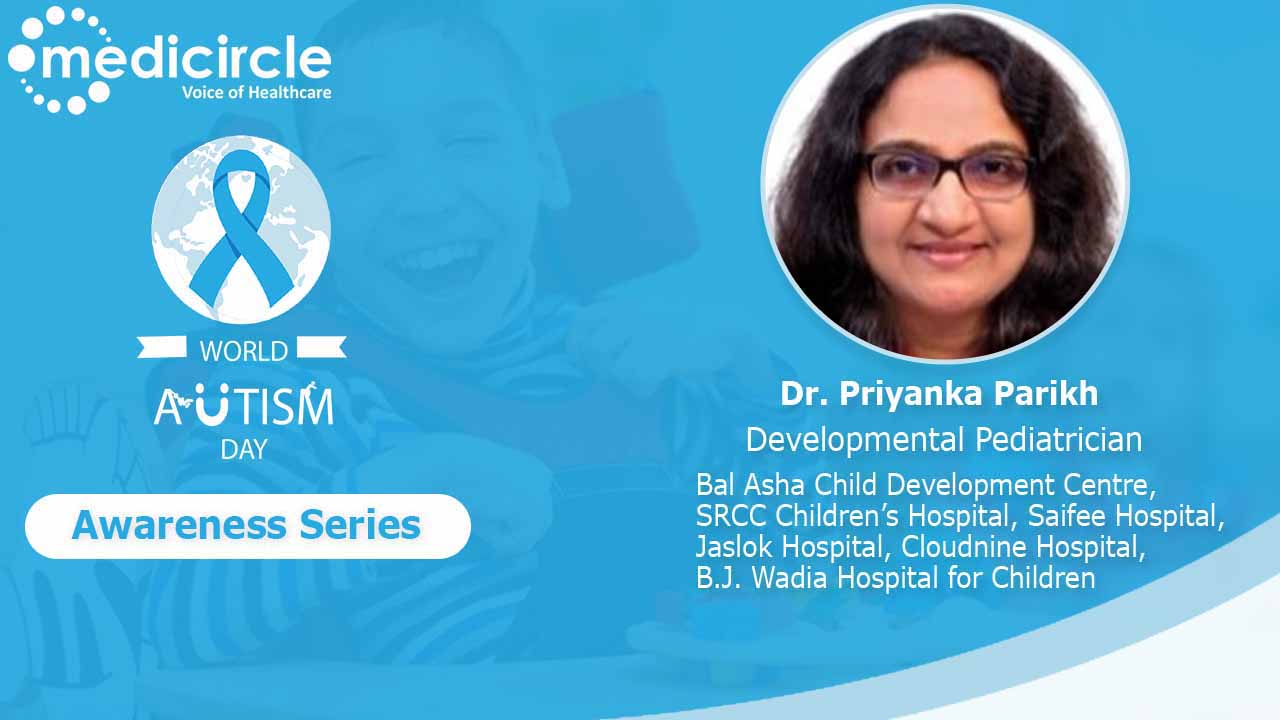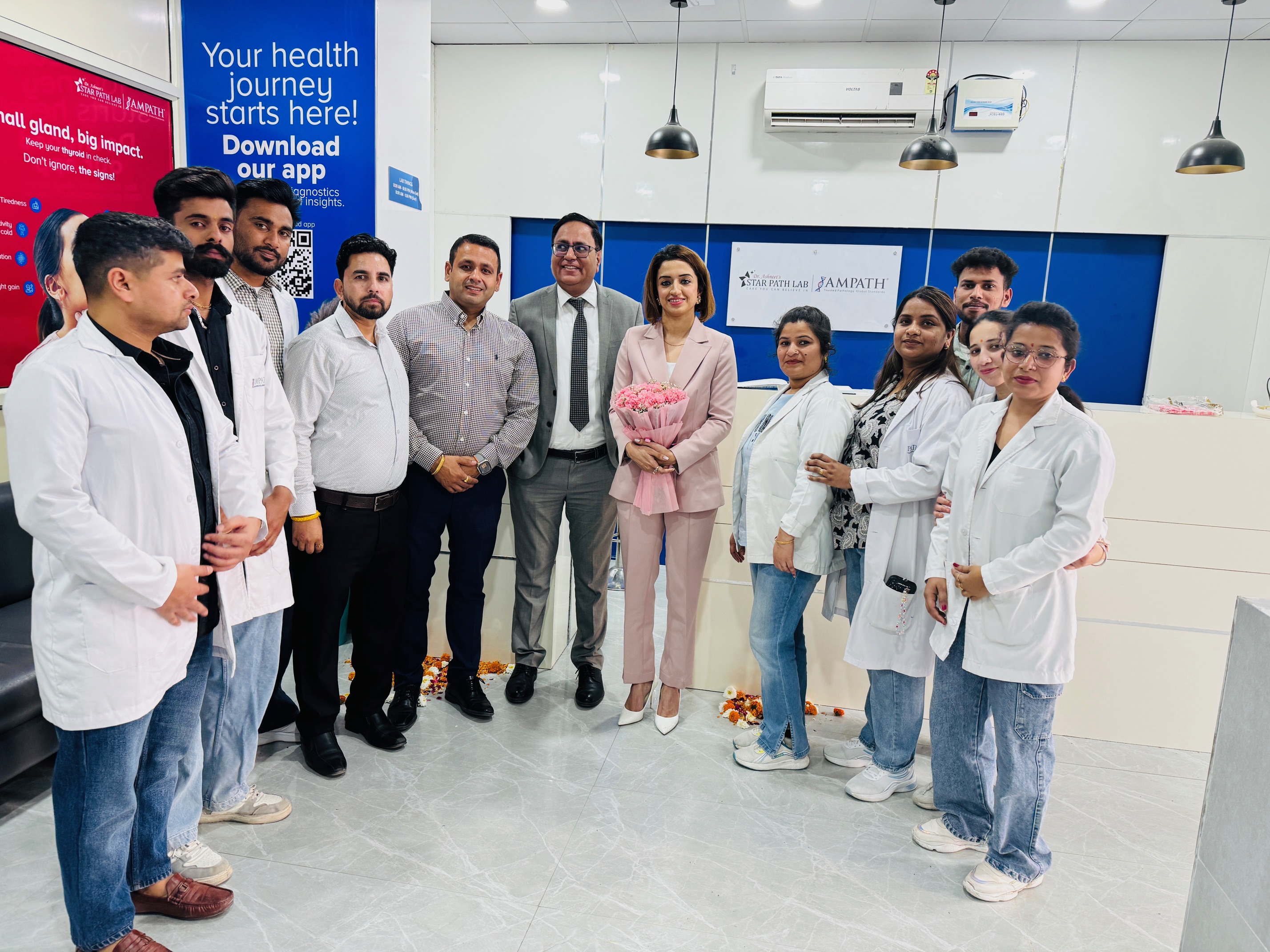Autism is a developmental disorder that impairs the ability to communicate and interact. Autism spectrum disorder impacts the nervous system and affects the overall cognitive, emotional, social & physical health of the affected individuals. It typically appears during early childhood. On the occasion of World Autism day that falls in April, Medicircle is conducting an awareness series to help build more understanding towards people suffering from this disorder.
Dr. Priyanka Parikh is a Developmental Pediatrician. She had completed her MD, DNB, DCH, and FCPS in Pediatrics from Mumbai, securing rank 2nd at MD and a Gold Medal at the FCPS examination. She then completed her MRCPCH from London and got training and experience in Developmental Pediatrics from both London and Mumbai. She is associated with Bal Asha Child Development Centre, SRCC Children’s Hospital, Saifee Hospital, Jaslok Hospital, Cloudnine Hospital, and is an Honorary at the B.J. Wadia Hospital for Children. Her areas of expertise include Autism, Attention Deficit Hyperactivity Disorder (ADHD), Learning disabilities (dyslexia), Slow Learners, Developmental delay, Cerebral Palsy, Syndromes like Down’s, etc. She has been a Clinical Fellow at the Pediatric Neurodisability Clinic, Northwick Park Hospital, London, and a Consultant at the Learning Disability Clinic, Sion Hospital. She has many presentations and publications to her credit.
Autism is one word but a big spectrum
Dr. Priyanka mentions, “When we talk of autism, it is one word, but it is a big spectrum. So, it is a developmental condition. Children and individuals with this condition have difficulties with social interactions with other people and in engaging and communicating with other people. They have limited play skills, and also many of them have a repetitive factor in their behavior. So, when I say developmental, it means that children with autism are born with autism and it is related to aspects of childhood development,” says Dr. Priyanka.
Autism predominantly affects the social and communication domain of development
Dr. Priyanka emphasizes, “When we say development, there are so many aspects to development - Children develop their physical skills, motor skills, they learn to walk, run, jump, they learn to do a lot of things with their hands. Similarly, they are learning communication skills, language, understanding people, talking to people, interacting with people, learning to play with things, feeling emotions. Autism is that condition, which affects mainly social, as well as the communication domain of the development predominantly along with other patterns of behavior that we see. And also, many children do have different ways in which to react to various aspects in their surroundings.”
It is important to identify the red flags in behavior
Dr. Priyanka explains, “It is very important to look at and identify those early signs. So, when I speak of diagnosing autism, I would diagnose autism, maybe at 2 years or sometimes even younger, at even 18 months, However, there are a lot of signs which come even before that. It is a condition that affects more social as well as a communication domain. How does an infant communicate and engage in interactions with babies, we need to think of that. So, even as early as 3 months, typically, a child will learn to recognize the mother, will learn to smile at the mother.
By 4, 5, or 6 months, there is a lot of to-and-fro interaction happening between parents and the child and with other caregivers. They respond to parents with a lot of sounds, smiles, and laughs. So, they are engaging in a lot of what we call it to-and-fro interaction. As they start getting older, they start understanding their name, they start responding to their name called by the parents and other members of the family. However, in children with autism, as early as 3,6,9 months, we see that these typical aspects of social communication are missing. Children may not be looking at their parents, they may be looking at objects, they may not be responding or consistent in looking when called by name. It’s an inconsistent response, looking sometimes and not looking at you. They display more interest in objects. So, if a mobile phone rings, the child may run towards a mobile but if a parent is calling, the child may just ignore that. Hence, not responding to the name, not giving enough eye contact, and also not showing enough non-verbal communication which is an important aspect of communication is found in behaviors of children with autism. A very important aspect of communication is what is called pointing. So even before a child learns to use the words like “mamma” the child will point at the food or what the child wants and will communicate to the parent and there is a lot of this nonverbal communication which starts developing even before the communication with words.
When the child wants to be picked up, the child will raise hands. So, the child is communicating with actions, gestures, facial expressions, but we see that in children with autism, the children are not even able to communicate and not pointing or even responding to parents pointing to them. A child with autism will not point to even share the joy of watching things, or the excitement of experiencing different things in the surroundings, and will also not adequately respond to others pointing out things to him or her. So, a lot of these aspects show the red flags. A child would generally babble by 6 months, 9 months, by 1 year, and would speak at least one meaningful word. But if the child is not yet speaking, the first words which come in the first year of life. And as the child grows older, by 2 years, if the child is not joining two words to make phrases like mamma-papa, that would be a red flag. So, we need to pick up those early signs of autism,” explains Dr. Priyanka.
Parents should identify red flags and immediately consult a developmental pediatrician
Dr. Priyanka advises, “It is important to pick up early signs and intervene early. So even before the diagnosis of autism, if one is seeing some signs, one can intervene. One doesn't have to wait for a diagnosis or a name to be given to the condition. So, it is very important for parents to see the red flags, or if they're even picking up some concerns, to immediately meet developmental pediatricians. It's always important to start with early intervention rather than waiting, and then monitor the evolving behaviors further going on.”
Autism is not an infection or disease, it’s a developmental condition ascertained through behavioral evaluation
Dr. Priyanka emphasizes, “Autism is a developmental condition, and children are born with it, so it is not a disease or it is not an infection, which you get, typically with germs infecting your body like typhoid, malaria, etc. It is not something that involves external infection. It is something that a child is born with, and there is a genetic basis to it. There are a lot of factors like environmental factors and a combination of genetic and environmental factors. Since it is not something that a child has got through acquired infection. There is no medical cure for autism. There are no tests to diagnose autism like a blood test or a CT scan or an MRI. The diagnosis is based on the identification of the behavioral pattern of the child. We use some specific tools to corroborate our findings. It is mainly a behavioral evaluation.”
A multidisciplinary approach is applied to help children with autism
Dr. Priyanka informs, “There are a lot of interventions, what we call a multidisciplinary intervention. It is multidisciplinary because there are several professionals involved. Also, there is a role of medications in some select individuals. A lot of different therapies are used to help the child with communication, to help the child interact, engage with people, and develop play skills. An important aspect of autism is what is called pretend play skills, where the child learns to pretend to feed a baby or pretend to give a bath to some of the animal toys. There are interventions to work on a lot of different skills. There are different therapies like speech therapy, facial therapy, different behavioral interventions to help the child lead a better life. There may be some children who may have extreme hyperactivity or extreme aggression or extreme self-harming behaviors. There may be some children who may have epilepsies or even gut-related issues. So, we may have to use medications to help control the comorbid conditions that we see. So, it is a combination of interventions, and it is not something like a one-size-fits-all. It is not something for which you just write a prescription. Every child with autism is different. We need to tailor the interventions for every child,” says Dr. Priyanka.
There is a need of supportive families and supportive environments for children with autism
Dr. Priyanka points out, “What is most important, in addition to interventions, is a supportive family, a supportive environment, people to have acceptance and understanding of the condition as well as with schooling, what we call is inclusive schooling. So, it is not just, you know, limited to the child and the therapist and the parents, but it's, that broader understanding at the level of the society because a child needs support throughout. So, it is not about just doing the skill in the therapy room but also when the child is out in the world, out into school, out with other children, out with the teachers, and in different social situations. it will go a long way to what we call is inclusive acceptance. They should be given opportunities to participate in different activities in the school, whether it is sports or other activities. Later on, there should be inclusiveness in job opportunities. We should maximize their abilities and help them to utilize their full potential,” says Dr. Priyanka.
(Edited by Amrita Priya)

 Children with Autism display more interest in objects. So, if a mobile phone rings, the child may run towards a mobile but if a parent is calling, the child may just ignore it. Not responding to the name, not giving enough eye contact, and also not showing enough non-verbal communication is found in behaviors of children with autism – Dr. Priyanka
Children with Autism display more interest in objects. So, if a mobile phone rings, the child may run towards a mobile but if a parent is calling, the child may just ignore it. Not responding to the name, not giving enough eye contact, and also not showing enough non-verbal communication is found in behaviors of children with autism – Dr. Priyanka 









.jpeg)


.jpg)





.jpeg)

.jpg)





.png)


